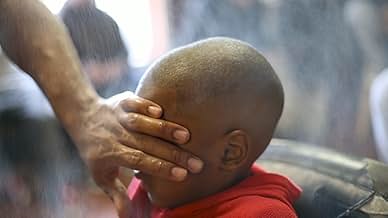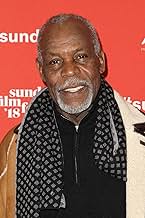PUNTUACIÓN EN IMDb
6,4/10
2,2 mil
TU PUNTUACIÓN
Añade un argumento en tu idiomaA kaleidoscopic and humanistic view of the Black community in Hale County, Alabama.A kaleidoscopic and humanistic view of the Black community in Hale County, Alabama.A kaleidoscopic and humanistic view of the Black community in Hale County, Alabama.
- Nominado para 1 premio Óscar
- 16 premios y 21 nominaciones en total
Argumento
¿Sabías que...?
- CuriosidadesThe film was based on Ross' s moving to Alabama in 2009 to live with the families he would be filming, and to almost a decade of observations among their community.( in contrast, when James Agee and Walker Evans went to Alabama in 1936 to document the poverty of the Depression there, they only spent three weeks .)
- ConexionesFeatured in The Oscars (2019)
Reseña destacada
With documentaries, we are used to being explicitly told the narrative. We are used to linear storytelling. We are used to talking heads, some witty banter with the filmmakers, an occasional irreverent interviewee, and some title cards at the end to explain what happens to everyone after the project has finished. With "Hale County This Morning, This Evening," not only are these items nonexistent; there's barely any context for the film we're left with.
The only context we're given is delivered quickly, right up top, explaining that RaMell Ross, the director, began the project in 2009 as he was tracking the local basketball team. There's a considerable focus on these teens in the final cut of the film, but there's much, much more, too.
There's Daniel, the basketball star who dreams of getting his family out of poverty through attending Selma University. There's Boosie, caring for her child with two more on the way. There's Quincy, Boosie's husband, whom we first meet crying as he has his nose pierced. And there's, of course, Quincy and Boosie's kid, a hyperactive youngster who adores the camera.
Through each of these characters and a handful of peripheral personalities, "Hale County" constructs a dreamcatcher of moments -- I hesitate to call them stories, given how loosely the film treats them, so "moments" is more appropriate. But in those moments, the African-American, low-income world of Hale County breathes deeply, forcefully. A police officer stops a car, and a deer steps out, trepidatiously, onto the road to get a better view. Its breath comes out in billows of condensation. At another point in the film, a young man stands with his father as a thunderstorm crackles over the horizon. The wind tugs at their clothes and threatens to pull them away.
Beyond these standout moments, aided by Ross' divine cinematography and precise editing, the majority of the film is told through the perspective of children. The best shot in the film sees a plane gushing a smoke trail as it falter in mid-air and falls, dramatically, plumes running behind it. As it falls, in one continuous shot, we find ourselves staring at Quincy and Boosie's child, crying, so close to the camera that you can see the tears sparkle.
For narrative lovers, "Hale County" will understandably disappoint. It fires on the levels that "Samsara" and "Baraka" do -- this is a tonal piece more than a narrative one. To this end, however, the sound recording leaves a lot to be desired. Some of the flourishes work, like leaving in a rough, barely audible background conversation between the filmmaker and a chatty subject. But most of the film features poor recording, and much of it with unmic-ed subjects. At a certain point, I stopped trying to understand what people were saying and just watched for the visuals and the music.
If you go with the film and let it take you on its winding, existential journey, "Hale County" travels the breadth of the human experience, from a blissful two-plus-minute shot of an infant running to and fro across the room like an excited puppy to a solemn view of smoke from a burning tire, cascading over trees as it reaches toward the sky.
Some parts of "Hale County" hit me harder than "Won't You Be My Neighbor," another, more widely seen doc from this year. In those scenes and in the more quiet, reflective moments, the movie calls to mind that trope about the "long night of the soul." "Hale County" isn't THAT dramatic, but its humanism and its experimental storytelling capture, hauntingly and beautifully, the morning and evening of the soul.
The only context we're given is delivered quickly, right up top, explaining that RaMell Ross, the director, began the project in 2009 as he was tracking the local basketball team. There's a considerable focus on these teens in the final cut of the film, but there's much, much more, too.
There's Daniel, the basketball star who dreams of getting his family out of poverty through attending Selma University. There's Boosie, caring for her child with two more on the way. There's Quincy, Boosie's husband, whom we first meet crying as he has his nose pierced. And there's, of course, Quincy and Boosie's kid, a hyperactive youngster who adores the camera.
Through each of these characters and a handful of peripheral personalities, "Hale County" constructs a dreamcatcher of moments -- I hesitate to call them stories, given how loosely the film treats them, so "moments" is more appropriate. But in those moments, the African-American, low-income world of Hale County breathes deeply, forcefully. A police officer stops a car, and a deer steps out, trepidatiously, onto the road to get a better view. Its breath comes out in billows of condensation. At another point in the film, a young man stands with his father as a thunderstorm crackles over the horizon. The wind tugs at their clothes and threatens to pull them away.
Beyond these standout moments, aided by Ross' divine cinematography and precise editing, the majority of the film is told through the perspective of children. The best shot in the film sees a plane gushing a smoke trail as it falter in mid-air and falls, dramatically, plumes running behind it. As it falls, in one continuous shot, we find ourselves staring at Quincy and Boosie's child, crying, so close to the camera that you can see the tears sparkle.
For narrative lovers, "Hale County" will understandably disappoint. It fires on the levels that "Samsara" and "Baraka" do -- this is a tonal piece more than a narrative one. To this end, however, the sound recording leaves a lot to be desired. Some of the flourishes work, like leaving in a rough, barely audible background conversation between the filmmaker and a chatty subject. But most of the film features poor recording, and much of it with unmic-ed subjects. At a certain point, I stopped trying to understand what people were saying and just watched for the visuals and the music.
If you go with the film and let it take you on its winding, existential journey, "Hale County" travels the breadth of the human experience, from a blissful two-plus-minute shot of an infant running to and fro across the room like an excited puppy to a solemn view of smoke from a burning tire, cascading over trees as it reaches toward the sky.
Some parts of "Hale County" hit me harder than "Won't You Be My Neighbor," another, more widely seen doc from this year. In those scenes and in the more quiet, reflective moments, the movie calls to mind that trope about the "long night of the soul." "Hale County" isn't THAT dramatic, but its humanism and its experimental storytelling capture, hauntingly and beautifully, the morning and evening of the soul.
- horsebeaverfoxman
- 30 ene 2019
- Enlace permanente
Selecciones populares
Inicia sesión para calificar y añadir a tu lista para recibir recomendaciones personalizadas
- How long is Hale County This Morning, This Evening?Con tecnología de Alexa
Detalles
- Fecha de lanzamiento
- País de origen
- Sitio oficial
- Idioma
- Títulos en diferentes países
- Округ Хейл вранці і ввечері
- Localizaciones del rodaje
- Hale County, Alabama, Estados Unidos(principal photography)
- Empresa productora
- Ver más compañías en los créditos en IMDbPro
Taquilla
- Recaudación en Estados Unidos y Canadá
- 112.282 US$
- Fin de semana de estreno en EE. UU. y Canadá
- 8640 US$
- 16 sept 2018
- Recaudación en todo el mundo
- 112.282 US$
- Duración1 hora 16 minutos
- Color
- Relación de aspecto
- 16 : 9
Contribuir a esta página
Sugerir un cambio o añadir el contenido que falta

Principal laguna de datos
By what name was Hale County This Morning, This Evening (2018) officially released in India in English?
Responde



















